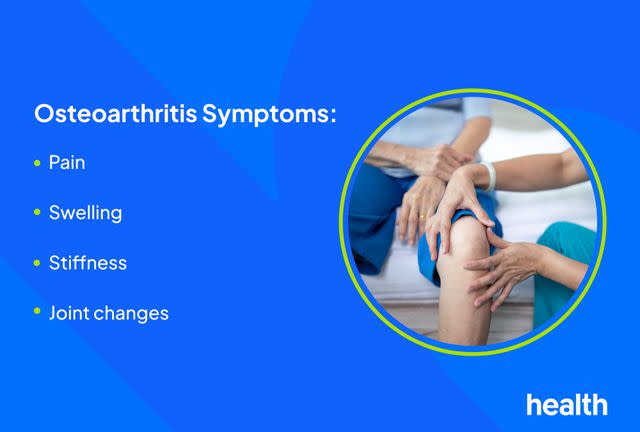Signs and Symptoms of Osteoarthritis
Medically reviewed by Forest Miller, OTR/L
Osteoarthritis (OA) is a common type of arthritis that causes a gradual breakdown of the tissues in a joint over time, eventually causing changes to your bones. Smooth cartilage (padding) in your joints allows your joints to move with ease. But with OA, your joints start to break down and the surfaces of your joints become more rough and pitted.
As a result, the joints can no longer move smoothly or cushion the bone during impact. When this happens, it's common to experience joint pain, stiffness, and swelling, among other joint changes.
Healthcare providers will classify osteoarthritis as primary or secondary. Primary OA occurs without any prior trauma or other health condition that can cause symptoms of osteoarthritis. Secondary OA often develops as a result of an underlying disease, injury, or deformity.
OA commonly develops in the joints of the hands, knees, hip, neck, and lower back—but can affect any joints and bones in your body. OA can also affect movement and cause weakness in muscles. You may notice the symptoms of OA flare-up after physical activity, trauma, repetitive motions, cold weather, infection, or changes in weight.
Related: What Is Arthritis?

Design by Health
Pain
Joint pain is typically the first symptom of osteoarthritis. The pain is usually a deep ache that comes and goes in the early stages. Pain in the weight-bearing joints like the knees and hips usually worsens with activity and is relieved with rest. In the later stages of the condition, pain can feel more constant and change from a dull ache to sharp, stabbing pains. You may also experience pain if someone touches your joints.
Swelling
When the cartilage in your joints begins to break down and becomes thinner, there is less cushion on the bones. This may cause more pressure on the joints. As a result of the increased pressure, the joint responds by creating more synovial fluid—a type of fluid that helps lubricate the joint to allow for smoother movement. But the increase in fluid can cause swelling and inflammation that creates pressure and pain in the joint lining.
It's worth noting that joint swelling can occur inside and around the joint. Excessive activity, or overuse of a joint, can lead to an increase in the amount of swelling you experience.
Stiffness
Stiff joints are a common symptom of OA. The reason you experience stiffness is due to excess inflammation in your joints. Stiffness tends to worsen right after you wake up or after periods of inactivity. In most cases, stiffness lasts around 30 minutes and improves when you move the joints.
Some people with joint stiffness can still move their joints but it may require extra effort. As OA worsens, the joint can become more challenging to move, making it hard to bend or straighten your affected joints fully. As a result, changes in flexibility and mobility can often occur.
Joint Changes
As your joints start to break down, you'll likely experience some joint changes—including changes in the appearance of your joints. Your body will attempt to repair joint tissue, which can cause an overgrowth of new bones and other tissues. The overgrowth can create bumps or growths on the edges of your joint (which are called osteophytes) that you can see and feel. The joints of the fingers are a common place for these bony growths to develop.
Changes to the joint can also affect your range of motion. When the cartilage breaks down, it creates a rough, irregular surface on the bone. This irregular shape can cause a feeling that the joints are grinding or cracking with movement. You may also feel like your joints are loose or unstable. Osteoarthritis that affects the knees may also cause muscle weakness, which may affect your ability to move or walk.
When to Contact a Healthcare Provider
Everyone experiences some type of body pain from time to time. But it's essential to seek care if you suspect arthritis might be causing your pain. Osteoarthritis is a progressive condition, meaning it only worsens as it continues.
Joint pain that happens occasionally or is mild doesn't always require immediate evaluation from a healthcare provider. But, if you're experiencing symptoms in your joints that last for more than three days or have multiple episodes of joint symptoms in a month, it's a good idea to contact your healthcare provider. It's also essential to talk to your provider if you are having difficulty moving one or more of your joints or if your symptoms interfere with your daily activities.
Experts suggest seeking medical care immediately if you experience any of the following symptoms:
Joints that appear red, hot, or swollen
Unusual swelling or rash that occurs with a fever
Unexpected and throbbing pain in your spine
Questions to Ask Your Provider
If you decide to talk to your provider about your symptoms, it can help to have some questions prepared before your appointment. Consider the following:
What lifestyle changes can help reduce my joint pain?
When should symptoms begin to get better after I start treatment?
Do you recommend physical therapy or medication to help improve my symptoms?
Can my condition lead to any serious complications?
A Quick Review
Osteoarthritis occurs when tissues of the joint break down. Symptoms include pain, stiffness, and swelling—all of which can lead to changes in your joint appearance and a decreased range of motion. These symptoms typically occur for a short period after inactivity or sleep, but tend to get better with movement. If you're experiencing pain that affects your daily activities and functioning, your healthcare provider is best fit to offer guidance and support.
For more Health.com news, make sure to sign up for our newsletter!
Read the original article on Health.com.

